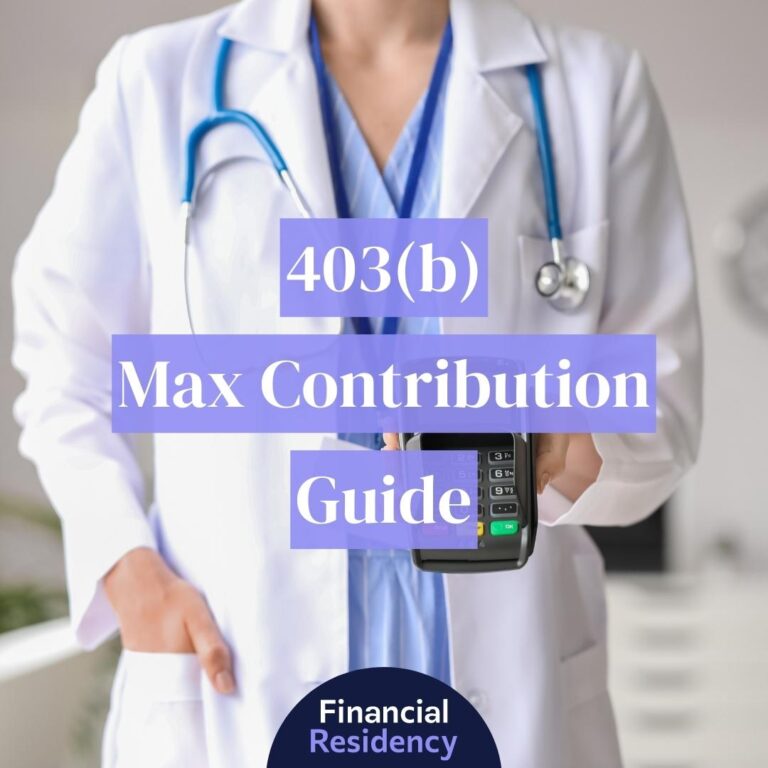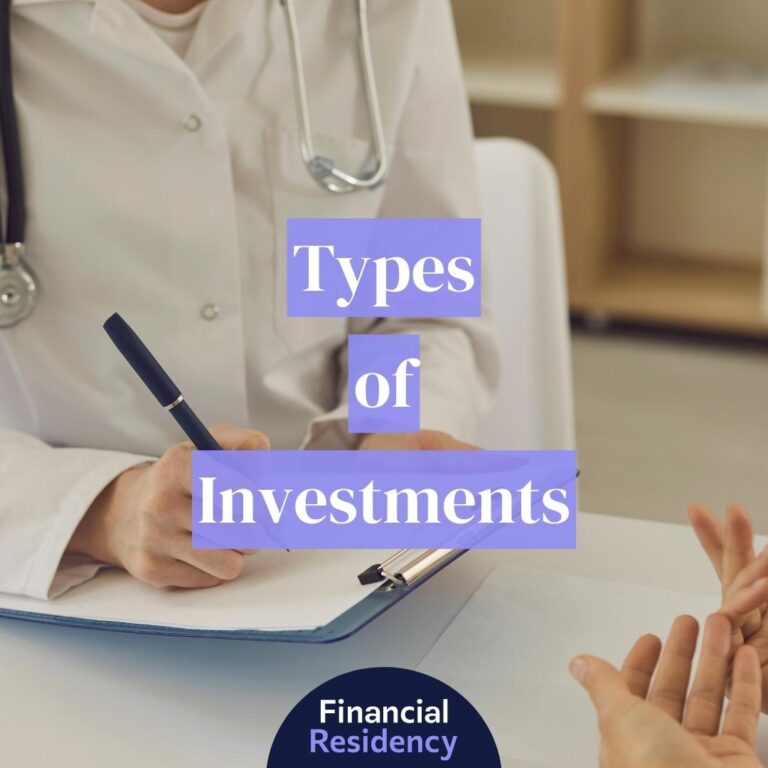We’ve dug deep into the best investments for doctors, so you can begin investing with confidence.
Managing and understanding your personal finances might as well be the wild, wild west.
There isn’t a class in school on investing, financial planning, or increasing your cash flow, yet many doctors become high-income earners with access to more money and resources than ever before.
The key to making the most of this privileged position is arming yourself with the best financial education you can. Interested in learning more about investing?
You’ve come to the right place. Keep reading to develop your understanding of how you can begin taking advantage of the best investments for doctors this year.
12 Best Investment Strategies for Doctors
Because physicians are high-earners, they often have access to investment options the general public doesn’t have the skills or disposable income to take advantage of.
With these additional investment options come opportunities for smart asset allocation. Asset allocation is an investment strategy in which someone decides how to spread their money across the market.
Smart asset allocation thoughtfully balances risk and reward with the timeline for when you want access to your money and other financial goals.
We’ve pulled together twelve unique investment opportunities for doctors. You can consider these opportunities on your own or take them to your trusted financial advisor––either way, we’d recommend you focus on diversification by looking at a combination of the following strategies.
- Reducing Debt
- High-Yield Savings Accounts
- Certificates of Deposit (CDs)
- Private Practice
- Medically-Adjacent Business
- Index Funds
- Mutual Funds
- Individual Bonds
- Individual Stocks
- Exchange-Traded Funds (ETFs)
- Real Estate
- Art and Other Appreciating Assets
1. Reducing Debt
The average physician has more than $200,000 in debt––just from medical school. This figure doesn’t include other common debts, like credit cards and undergraduate student loans.
Prioritizing paying off this debt can be considered an investment in yourself. Debt is also subtracted from your total net worth, so paying down debt has its advantages.
Not only will you no longer accrue interest on paid-off debt, but you can also put the money you would be putting towards loan repayment toward other investments.
You can pay off debt quickly by using one or more of the following strategies:
- Make more than one monthly payment
- Pay more than the monthly minimum
- Pay off your loan with the highest interest rate first
- Enroll in AutoPay
- Consolidate or refinance loans
- Consider the snowball method
Learn More:
2. High-Yield Savings Accounts
Keeping your surplus funds in a traditional checking or savings account is throwing away the opportunity to earn interest on it.
If you’re not yet ready to take the risk of other investments, opening a high-yield savings account can give you access to interest rates more than three to four times the national average.
Consider asking your current bank or credit union for their current high-yield savings account offers, but don’t hesitate to shop around. Online-only banks, like Ally Bank, often offer competitive interest rates due to their lower operating costs.
High-yield savings accounts offer investors the opportunity to earn compounding interest, or in other words, earn interest on previously earned interest.
3. Certificates of Deposit (CDs)
A Certificate of Deposit (CD) is a bank-issued savings product where investors can earn a fixed rate of interest on a lump sum of deposited money. The catch is that the entire sum of this money must remain untouched for the entire loan term or you could incur penalties for early withdrawal.
CDs are a very accessible way to grow your money because almost every institution offers them in its suite of products. CDs often have a locked interest rate, which means they will earn a fixed interest rate throughout the loan term. In general, longer CD terms will be eligible for higher interest rates.
CDs can be a very low-risk investment for physicians who want to earn interest on their money, but they won’t need access to it for the term. CD terms start as low as three months and may mature up to five years, but some institutions may offer terms of up to 10 years.
4. Private Practice
Physicians have a number of investment opportunities in private practice. The most obvious opportunity is starting your own private practice, but it’s far from the only opportunity. Rather than starting your own brand from scratch, you can buy into an existing practice.
According to a 2021 Medscape report on physician compensation, employed physicians make about $300,000 annually while self-employed physicians can make up to $52,000 more on average. Physicians who buy into an existing practice can further increase their income without taking time away from their full-time jobs.
Starting, partnering, or investing in a private practice has more than just financial benefits though. Working outside a hospital is often lower day-to-day stress and ownership comes with a lot more autonomy.
Many private practice physicians have started offering direct primary care, a concierge medicine model that circumvents insurance with a regular subscription. With this model, physicians are often able to accommodate longer appointment times and treat patients without insurance companies’ red tape.
5. Medically-Adjacent Business
Increasing income is a great way to increase investment potential. While starting a primary practice may seem like the obvious path, doctors are uniquely suited for medically-adjacent businesses.
If you hire an operator or work with a partner, you may even be able to turn the following businesses into passive income streams:
- Dental lab or clinic
- Dialysis center
- Endoscopy center
- Health insurance consulting
- Hospice
- Imaging center
- In-home healthcare
- Integrative or holistic medicine practice
- Lab
- Medical billing
- Medical equipment sales
- Medical massage
- Outpatient surgical center
- Private ambulance service
- Software development for pharmaceutical companies
- Supplement business
- Urgent care center
- Wellness Coaching
Opening a business is a good way to alleviate the uncertainty of the stock market while exercising a lot of transferable skills. It can also create the opportunity to extend your reach as a physician without requiring you to be in two places at once.
6. Index Funds
Index funds perform relative to a collection of stocks on the market, such as the Standard and Poor’s 500 Index, also known as the S&P 500.
Index funds are often a strong investment for long-term investors. They’re also hands-off and low-fee in many cases. Index funds often have lower fees than actively managed funds because they employ a more passive investment strategy.
While many types of investments are meant to anticipate the market, index funds seek to set the market. Actively managed funds are concerned with day to day buying and selling of specific stocks, while index funds have the advantage of looking at more big-picture perspectives.
Examples of popular index funds include:
- S&P 500
- Dow Jones Industrial Average
- Nasdaq
- Vanguard Total Stock Market Index Fund Admiral Shares
- Fidelity 500 Index Fund
After you’ve researched and selected the index funds that interest you, you can purchase index fund shares from a brokerage or bank.
7. Mutual Funds
Mutual funds collect funds from a pool of investors and a Fund Manager manages the investments according to the values, financial goals, and risk tolerance of the pool.
There are a few different types of mutual funds. Money market funds are limited to a strict set of high-quality short-term investments issued by the U.S. government. Money market funds are considered relatively low risk.
Bond funds are designed to produce higher returns and thus carry slightly more risk than money market accounts. The risk and return of these funds can vary based on the type of bond.
Stock funds invest in corporate stocks or shares of publicly traded companies. Mutual funds are different from index funds in that mutual funds have a varying list of securities whereas index funds are limited to a specific list of securities.
8. Individual Bonds
Bonds are an essential part of a diversified portfolio. In general, they’re lower-risk investments because they are used to raise funds for specific projects and they typically have a clearly defined date of return.
There are three main types of bonds:
- S. Treasury (T-bonds): T-bonds are U.S. Treasury-backed bonds with a low-interest rate, but they’re 100% risk-free.
- Municipal: Municipal bonds are issued by a city or state government to raise money for public projects, such as new infrastructure. The interest earned on these bonds is tax-free.
- Corporate: Corporate bonds are issued by private companies to raise money for research, development, or expansion. The interest earned on these bonds is taxable, but the rates are often more aggressive than other types of bonds to compensate.
You can purchase bonds at any time. The U.S. Treasury bonds start as low as $25 per bond, so it can be a very approachable way to grow your comfort investing.
9. Individual Stocks
For doctors with an interest in the stock market, trading individual stocks can be incredibly lucrative when actively managed.
Even doctors with less stock market fortitude can start educating themselves and purchasing single shares with the numerous investment apps popping up every year.
You can also work with a licensed financial advisor to get the most up-to-date advice on individual stock options.
Individual stocks give physicians who want a more active role in the investing process the opportunity to buy, sell, and trade at their own discretion.
Learn More:
10. Exchange-Traded Funds (ETFs)
Exchange-traded funds (ETFs) operate very similarly to mutual funds. Like mutual funds, ETFs are pooled investments that track an index or set of securities. However, unlike mutual funds, ETFs can be traded as easily as individual stocks.
ETFs can be traded at any time of day and the price fluctuates throughout the day. ETFs can hold US-only securities or they can have a mix of international assets as well. Like mutual funds, the performance of an ETF is related to the performance of a given index.
One of the most popular ETFs is SPDR S&P 500 ETF and it follows the performance of the S&P 500 Index.
ETFs may be attractive to doctors because they offer many of the same benefits as trading individual stocks with the benefit of fewer fees and lesser exposure. ETFs can be a great part of any diversification strategy.
11. Real Estate
There are virtually endless methods of investing in real estate. Physician loans can make it easier for early-career medical professionals to begin building equity by purchasing their dream homes. Some physician mortgage lenders, like KeyBank, even provide special financing for second homes.
If you already own your home, you can continue dipping your toes in real estate investment by refinancing your home and using the cash you save to purchase a rental property. However, self-managed rental properties can quickly become time-intensive projects, so they’re not always the right choice for busy physicians.
- REITs: Real estate investment trusts (REIT) are another way to dip your toes in real estate investment. REITs are companies that own income-producing properties. Like mutual funds, everyday people can invest in REITs without needing the upfront capital it usually takes to get into real estate. REITs are a valuable path to earning passive income through dividends. REITs typically make money by leasing space and collecting rent.
- Crowdfunding: Real estate crowdfunding is similar to REITs in that it allows a group of people to pool funds together to purchase income-producing property. Real estate crowdfunds are often overseen by an entrepreneur or passionate project manager who wants to expand the reach of the project beyond the usual group of investors, such as venture capitalists. Crowdfunding allows everyday people to begin investing in real estate without worrying about being overleveraged or getting approved for a mortgage.
12. Art and Other Appreciating Assets
Art is considered a valuable long-term investment strategy because it’s likely to hold value or appreciate over time. In other words, it’s a solid investment for people who don’t have the risk tolerance for market volatility.
However, art isn’t the only worthwhile appreciating asset. If you’re a natural collector, you can build wealth by acquiring antiques, jewelry, vintage cars, toys, stamps, coins, and other valuables.
With that said, it’s worth noting that these types of investments often have additional overhead costs, such as storage and maintenance. For this reason, we recommend considering art and collectibles a hobby or a supplement to an already diversified portfolio.
Without sufficient time investments, it can be difficult to turn a profit from this form of collecting, but that ultimately comes down to the item and its desirability.
Benefits of Investing
The benefits of investing are manifold. In general, investing can help savvy participants combat rising costs of living while building wealth, planning for retirement, and reducing income tax liability.
A financial advisor can help you better understand what types of investments you can make to achieve your financial goals. You can plan for retirement, increase your net worth, and reduce financial liability just by putting your money in the right accounts.
For example, 401Ks and traditional IRAs are not taxed when you put money in them. Instead, you will pay taxes on this money when you make a future withdrawal. As such, maxing out your contributions to these funds can reduce your taxable income.
Typically, it’s recommended that you max out these retirement plans before moving on to other investments. However, once you’ve mastered that, strategic investments can further help you achieve financial independence, build financial security, and even retire early.
Risks of Investing
Investing isn’t without its risks, so it’s important to be thoughtful about your risk tolerance before you hedge any bets. Many financial planners and investing apps will even have a quiz to help you hone your risk tolerance as part of the onboarding tolerance.
Different investments will carry different risks, so your risk tolerance will have a big role in your investment options.
The common risks of investing include:
- Market risk: Security could lose its value
- Liquidity risk: Security could fail to convert to fair-market value in cash
- Concentration risk: Investors could fail to diversify by investing in one type of security
- Credit risk: The issuer could default on the bond due to financial difficulties
- Reinvestment risk: Reinvested funds lose out on higher returns because they’re now earning a lower rate of interest
- Inflation risk: Reduced purchasing power because the investment doesn’t have greater returns than the rate of inflation
- Horizon risk: Occurs when an investor has to pull out of the market before it hits its maximum return due to unforeseen circumstances
- Longevity risk: Occurs when an investor outlives their savings or has expenses that exceed their retirement planning
- Foreign investment risk: Occurs when conditions outside the United States affect investments in other countries
Working with a fee-only financial advisor with a fiduciary responsibility can mitigate many of these risks as can building your financial literacy, staying abreast of market conditions, and making sure you have diversification in your investments.
What to Consider When You Invest
Before you can start making investments, it’s important to take a thoughtful inventory of your financial goals, risk tolerance, and available opportunities.
It’s also a good opportunity to seek out tax advice so you can eliminate surprises and best understand the extent of your liabilities.
We recommend you consider the following before embarking on your investment journey.
Financial Goals
Before you can begin investing, you’ll want to zero in on your financial goals. It’s possible you have simultaneous financial goals, which is fine, you’ll just have to be intentional about your investments. Chances are you’ll have a mix of short-term and long-term goals.
Ask yourself what you’re hoping to get out of your investment. Is it a comfortable retirement, maybe even an early retirement? Will it increase your cash flow through passive income? Is it saving your loved one’s education or paying off medical school debt?
If you’re unsure of your financial goals, it can be helpful to start with a budget. Look at the income you bring in from your full-time job and compare it to the amount you’re losing to expenses. If there’s anywhere to trim the fat, now’s the time to do it, so you can better allocate funds to the right investments. At this point, you’ll also want to make sure you have amassed a comfortable emergency fund with enough money for at least six months of your fixed expenses.
It’s also a good idea to focus on paying down debt because no investment strategy will compensate for the interest accrued on unpaid debts.
Investment returns may be tempting, but the key to playing the market is being able to stay in it. A healthy emergency fund ensures you’re covered if you encounter unforeseen circumstances and expenses.
Risk Tolerance
At this point, you’ll need to evaluate your risk tolerance. Investments aren’t FDIC-insured like the deposits you put in your checking and savings accounts. As such, you could lose some or all of the money you invest.
All investments carry some form of risk, but they’re not created equal. Cash equivalents, such as U.S. Government Treasury bills and money market accounts, are considered the lowest-risk investments.
Securities, such as stocks, bonds, and mutual funds, are higher risk than cash equivalents, but not the highest-risk investments out there.
In general, the more risk you take on an investment, the greater return on investment you’re able to extract should that asset perform well.
You try to evaluate your risk tolerance on your own by asking yourself a few questions or you can go to a trusted financial planner for their insight.
Typically, risk tolerance assessments involve a series of multiple-choice questions, similar to the following:
- Protecting my portfolio is more important to me than high returns.
- Answer strongly disagree to strongly agree.
- With your above answer in mind which of the following statements makes the most sense to you?
- I am willing to bear the consequences of a loss to maximize my returns.
- I am concerned about losses along with returns.
- Completely avoiding losses is important to me.
- Which of the following statements best describes your investment philosophy?
- I feel comfortable with stable investments.
- I am willing to withstand some fluctuations in my investment.
- I am seeking substantial investment returns.
- I am seeking potentially high investment returns.
- What do you expect to be your next major expenditure?
- Buying a house
- Paying college tuition
- Capitalizing a new business venture
- Providing for my retirement
- Over the next few years, you expect the annual income to:
- Stay the same
- Grow moderately
- Grow substantially
- Decrease moderately
- Decrease substantially
Answering these questions honestly will help you make investments aligned with your risk tolerance.
ROI Timeframe
The goal of investment is to collect a return, but not all investments provide a return at the same rate. Before investing, you’ll want to evaluate the expected return and when you are able to access it. In the financial industry, this is also known as the investment horizon.
Defining your next major expenditure and when you expect it to come down the pike can give you a better idea of your investment horizon.
In general, short-term investments can be between one and three years. Medium-term investments are between three and seven years and long-term investments are between 10 to 30 years.
Tax Strategy
Investing isn’t only an opportunity to grow your money and maximize profits; it’s also a vehicle for minimizing income-tax liability when it’s done correctly.
Before making investments, we recommend setting a meeting with a certified public accountant (CPA) or another trustworthy financial advisor to make sure you’re investing in a tax-advantageous way.
A knowledgeable financial advisor will be able to advise you on the best tax deductions you have at your disposal.
The SEC also maintains a strong resource on how to invest wisely at any level of financial literacy.
The Bottom Line
The best investments for doctors are multi-faceted and ever-changing, which often means they require active management, advice from a trusted financial advisor, and diversification across several asset classes.
We recommend starting your investment journey by taking an honest look at your current spending and saving, then prioritizing retirement planning.
You’ll need to decide how much money you want to devote to recurrent retirement contributions, which you’ll want to center around maintaining your current standard of living well after you’ve stopped bringing in a full-time income.
Once you’ve decided how much you’re likely to need in retirement, you can work with a financial advisor to find out how you want to invest that money or you can focus on building your financial literacy by listening to podcasts, reading, and following current events.
After you’ve determined your risk tolerance and desired returns on your retirement funds, you can consider broadening your investment horizons by trading your own stocks, purchasing bonds, getting into real estate, or building a collection of other appreciating assets.
Investing, like all parts of personal finance, is highly personal and there isn’t a one-size-fits-all approach.
You’ll need to be scrappy, prudent, resilient, agile, and honest to get the most out of a market that constantly changes, but with the right tools, you can capitalize on massive returns.





